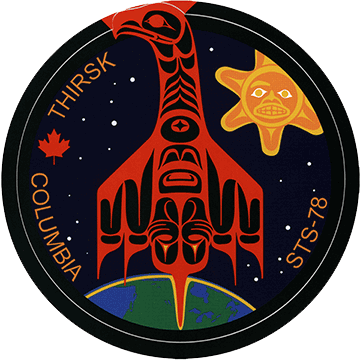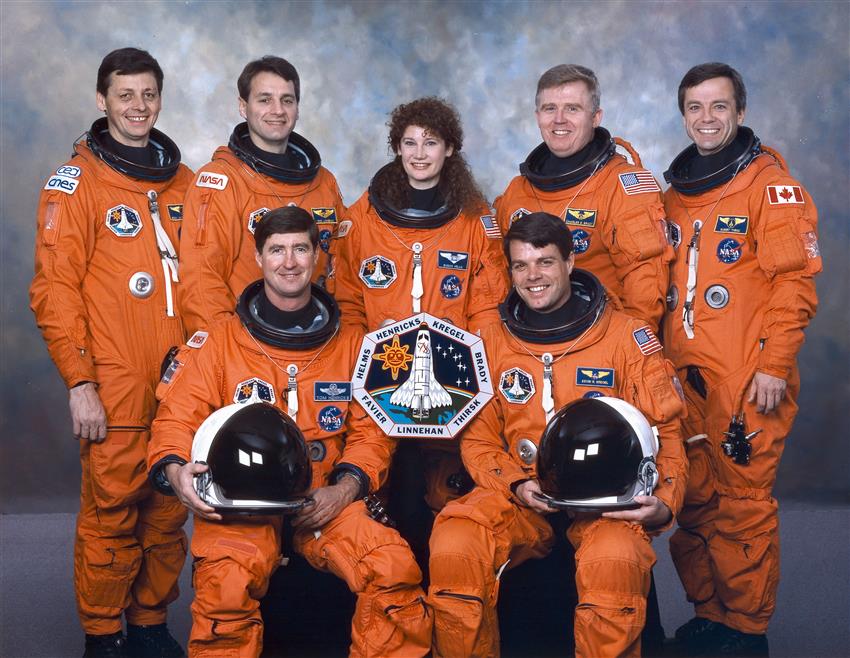Mission STS-078

Mission description

Text version
The Canadian Space Agency (CSA)'s crest celebrating Bob Thirsk's flight aboard STS-78 features the art and mythology of Canada's West Coast native cultures.
Central to the crest is a majestic eagle symbolizing Space Shuttle Columbia and its Life and Microgravity Spacelab Mission (LMS) payload. The form and lines of the eagle design connote the power of the shuttle as it overcomes Earth's gravity and enters the dark void of space and the domain of the Sun Chief.
Six pairs of experiment racks and the aft end cone of Colombia's Spacelab module are stylistically characterized within the eagle's chest. Within the abdomen, the extended duration orbiter pallet is represented by an ovoid while the eagle's legs and claws form the shape of the orbital maneuvering system engines. The feathers of the outstretched wings, traditionally symbolic of peace amongst West Coast natives, represent the professional bond of friendship amongst the shuttle team members both on Earth and in orbit.
The LMS focused on two scientific themes. As the ultimate energy source for all of life on Earth, the pulsating sun represents Columbia's 16 life sciences experiments. The crystal seen within the Spacelab module represents the 27 microgravity sciences investigations. A cornerstone of the LMS shuttle flight is the participation of many organizations and hundreds of people from around the world. Accordingly, the five Olympic colours (red, black, yellow, green and blue) featured in this crest symbolize the international cooperative nature of this mission. The yellow glow represents the crew and terrestrial society. Indeed, the work performed by the astronauts during this mission brought medical, technological, educational and social benefit to people of Canada and other space faring nations.
This crest was designed by Tsimshian artist Bill Helin of Parksville, BC.
Patch STS-78. (Credit: Canadian Space Agency)
Launch
Date: June 20, 1996
Time: 10:49:00 a.m. EDT
Site: Kennedy Space Center (KSC)
Landing
Date: July 7, 1996
Time: 8:37:30 a.m. EDT
Site: Kennedy Space Center (KSC)
Mission duration: 16 days 21 h 48 min 30 s
Flight number: STS-78
Orbiter vehicle: Columbia
Payloads: Spacelab-LMS (Life and Microgravity Spacelab), Space Acceleration Measurement System (SAMS-D), Orbital Acceleration Research Experiment (OARE), Thermocapillary Migration and Interaction of Bubbles and Droplets (TMIBD), Shuttle Amateur Radio Experiment (SAREX)-II.
The Life and Microgravity Spacelab Mission (LMS), a culmination of extensive efforts by an international team of scientists, engineers and support personnel, flew aboard Space Shuttle Columbia during STS-78. Canadian astronaut Bob Thirsk, on his first space flight, participated in the diverse slate of life and microgravity experiments, a total of 41 in all, conducted in the near-weightless environment of the LMS.
Canadian contribution to this suite of experiments included the Torso Rotation Experiment (TRE), led by McGill University in Montreal and sponsored by the Canadian Space Agency. Its findings helped to contribute to the search for a cure for motion sickness and morning sickness in pregnancy.
The short-term, shuttle-based research in the LMS was a pivotal step towards the long-term science now being conducted on the International Space Station.

Mission STS-78 crew
From left to right. Back row: Jean-Jacques Favier, Richard M. Linneham, Susan J. Helms, Charles E. Brady and Robert Thirsk. Front row: Terrence T. Henricks and Kevin R. Kregel. (Credit: NASA)